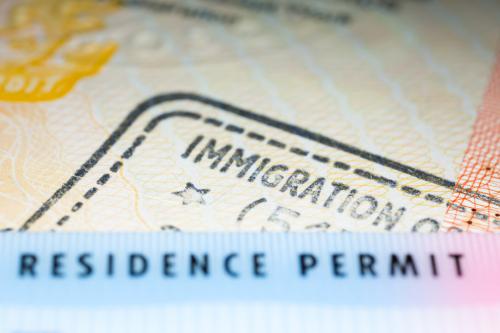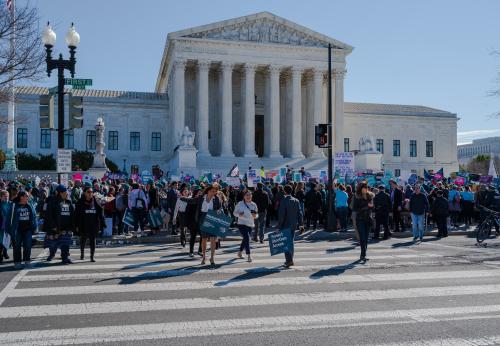If you want more content like this, subscribe to our newsletter.
This week in Class Notes:
- Poor mothers in receipt of unconditional cash transfers do not appear to spend more on alcohol or cigarettes.
- Increasing school choice in Los Angeles improved student outcomes and reduced class gaps by creating more competition between schools.
- Workplace sexual harassment reinforces gender segregation and the gender pay gap.
- This week’s top chart shows that the child penalty for heterosexual couples is much larger and longer-lasting than in same-sex female couples.
- Allison Schrager argues that increasing the number of temporary visas for jobholders (H-1Bs) could combat labor shortages and rising prices, in this week’s choice op-ed.
- Check out our new piece about how college access programs are using social capital to improve educational outcomes for students.
- For your calendar: Events on the health impacts of COVID-19, the role of higher education in reducing inequality, and the effects of redlining and blockbusting on the racial wealth gap.
Unconditional cash transfers aimed at poor families are unlikely to induce large changes in their substance use and expenditures
Critics of unconditional cash transfers to poor families often worry that the money will not be well spent – for example, going to cigarettes or alcohol. Paul Yoo and his co-researchers study the impacts of cash assistance using a randomized control trial of 1,000 low-income mothers who either received a substantial ($333) or a nominal ($20) monthly cash gift during the early years of their child’s life. They find that the $313 difference in cash transfers had small and statistically insignificant effects on mothers’ substance use and household expenditures of cigarettes or alcohol. Even among mothers who reported smoking or drinking alcohol before or during pregnancy, the effects of the extra cash were zero. In fact, less than 1% of the monthly income difference between the high-cash and low-cash groups is spent on alcohol and tobacco. These findings are useful to policymakers as they consider various options for improving the economic fortunes of low-income families, including permanent improvements to the Child Tax Credit.
The school Zones of Choice program in Los Angeles improved student outcomes because competition incentivized schools to improve quality
The Zones of Choice (ZOC) program in Los Angeles is a school choice initiative covering around 30-40 percent of all high school students in LAUSD, aimed especially at those from disadvantaged backgrounds. Christopher Campos and Caitlin Kearns assess the impact of ZOC by looking at both the supply and demand factors of the school choice decision. They find that ZOC led to gains in student achievement and four-year-college-enrollment (a 25% increase) large enough to close the existing gaps between ZOC students and other students in the district. These achievement gains are driven largely by improvements in school quality resulting from more competition among schools. The effects are strongest among students at the middle and bottom of the achievement distribution. School choice may then promote educational equity, depending on how the policy is designed and implemented.
Workplace sexual harassment is most severe for workplace gender minorities and reinforces gender segregation and the gender pay gap
Sexual harassment in the workplace has direct consequences for gender inequality in the labor market. Using nationally representative administrative and survey data, Olle Folke and Johanna Rickne study how men and women in Sweden describe sexual harassment risks in their workplaces and how they respond to these risks. Women are three times more likely than men to report sexual harassment, and men and women are both likely to report sexual harassment when they are in the minority in their workplace. Moreover, gender norms linked to occupation choices play a role in creating harassment risks, especially for men. Women who self-report harassment are more likely to leave and find a workplace with more women, but lower pay. The authors estimate that these effects of sexual harassment account for about 10% of the raw gender wage gap.
Top chart: The child penalty for heterosexual couples is much larger and more sustained than it is for same-sex female couples
This figure shows the first child penalty for heterosexual couples, same-sex female couples, and adopting couples in Norway, controlling for initial labor market advantages. Women in heterosexual and adopting couples have large and sustained child penalties, while same-sex female couples have smaller penalties that dissipate over time. The differences between heterosexual and same-sex couples, and the similarities between heterosexual and adopting couples, rule out childbirth or the father’s advantage in the labor market as mechanisms for the penalty. Instead, the authors find that preferences, gender norms, and discrimination are the main explanations.
 Source: Journal of Labor Economics
Source: Journal of Labor Economics
Choice opinion: Increasing the number of temporary visas for jobholders could combat labor shortages and rising prices
“America needs to start being [more] strategic in its immigration policy… Offering more permanent-resident visas may be hard to do politically right now. An alternative is to reform the temporary migrant program. Currently people can come to the U.S. as high-skilled workers if they are sponsored by an employer on an H-1B visa, which can be converted to permanent status. But the number of H-1B visas is capped at 65,000 each year, plus an additional 20,000 for students who complete U.S. graduate degree programs. These numbers fell off during the pandemic. We should offer far more high-skilled worker visas each year and provide working visas that can convert to permanent status for anyone who completes a college or graduate degree at a U.S. college or university in a STEM field,” writes Allison Schrager.
Self-promotion: College access programs are using social capital as a way to improve educational outcomes
Social capital is described, defined, and measured in a wide variety of ways. But it is often recognized as the network of relationships that provide support and/or opportunities to individuals. In our recent report (and event), we examine four specific programs to learn how they incorporate a social capital approach into their goals of improving college access and attendance. Some of the key lessons of these programs are that both bonding social capital (within existing groups or communities) and bridging social capital (across groups) is important, with families acting as important accelerators (or brakes) on student opportunities. Moreover, peer networks within cohorts can provide support during college; and relationships are most valuable when they start early and sustained over time. Finally, we acknowledge that more high-quality research of social capital interventions is necessary to determine the causal impact of social networks.
For your calendar: Events discussing the health impacts of COVID-19, the role of higher education in reducing inequality, and the effects of redlining and blockbusting on the racial wealth gap.
COVID-19 and Health Outcomes, Spring 2022
National Bureau of Economic Research
Friday, June 24, 2022 2:00 PM EDT – 5:00 PM EDT
Can College Level the Playing Field? Higher Education in an Unequal Society
Urban Institute
Thursday, July 7, 2022 4:00 PM – 5:00 PM EDT
Exploring the Racial Wealth Gap: The Contributions of Redlining and Blockbusting
Federal Reserve Bank of Chicago
Tuesday, July 12, 2022 2:00 PM – 3:30 PM EDT








Commentary
Class Notes: The impact of unconditional cash transfers, improving student outcomes, and more
June 23, 2022